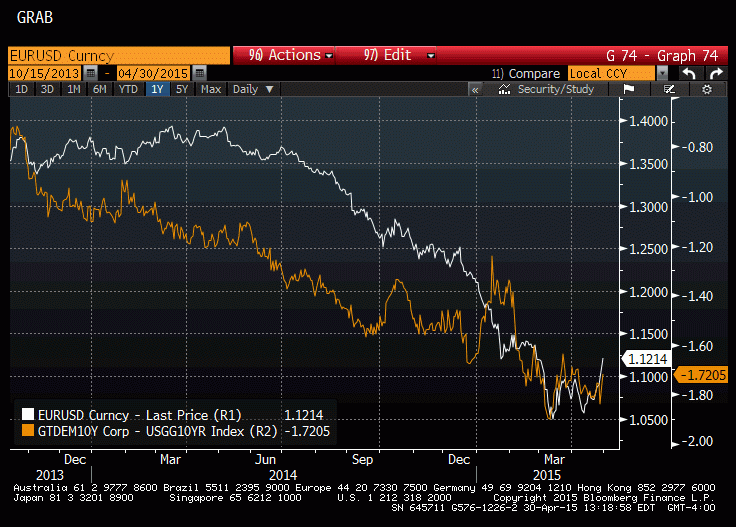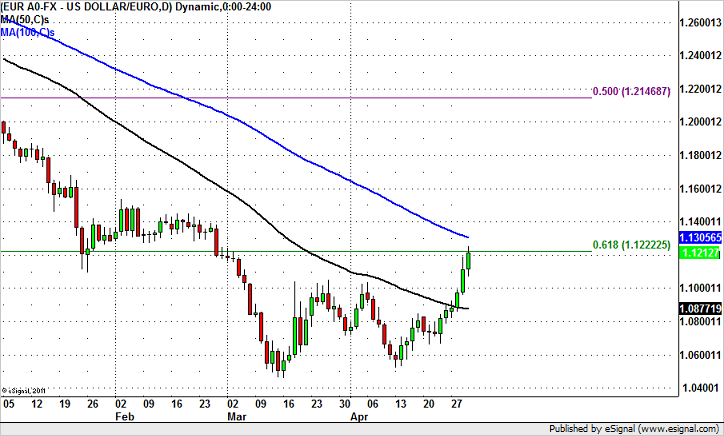By Kathy Lien, Managing Director of FX Strategy for BK Asset Management.
- 3 Reasons for the Euro's Mind Boggling Rally
- USD/JPY Bounces on US Data and BoJ
- USD/CAD Bounces Despite Data and Oil
- AUD Crushed by RBA Rate Cut Speculation
- NZD Recovers Post RBNZ Losses
- EUR/GBP Sees Strongest 1 Day Rise Since Feb 2013
3 Reasons for the Euro's Mind Boggling Rally
It has now become clear that investors used Wednesday's post FOMC intraday rebound in the dollar as an opportunity to buy the euro at a lower level. The single currency rose for the sixth consecutive trading day to its strongest level since February. The last time we saw such continuous strength without a pause or retracement was in March 2009 and at the time, the rally lasted for 8 trading days before the EUR/USD turned sharply lower, falling 800 pips in the course of a month. There are 3 reasons for Thursday's rally but before we get into them, the one thing that is NOT supporting the uptrend in the EUR/USD is fundamentals. Most of Thursday morning's U.S. economic reports surprised to the upside while the latest Eurozone data highlighted ongoing weakness in the Eurozone economy. German retail sales fell -2.3% in March, the steepest decline since December 2013. The unemployment rate for the Eurozone was expected to improve slightly to 11.2% but it held steady at 11.3%. The German jobless rate also remained unchanged at 6.4% as only 8k people fell off unemployment rolls compared to a -15k forecast. Moody's also lowered Greece's credit rating but EUR/USD traders ignored the move.
Three reasons behind the euro's mind boggling rally versus the U.S. dollar.
1. German-U.S. Yield Spread is Moving Higher!
U.S. yields were up Thursday but German yields moved even higher. The following chart shows how EUR/USD is being boosted by the German-U.S. 10-year yield spread, which started to turn higher right when the currency pair broke above 1.09.

2. Euro Accelerated Gains after Break Above 50-day SMA
The rise in the EUR/USD gained momentum after it broke above the 50-day SMA shown in the chart below. This was first time that the currency pair had done so since May. The move also accelerated as stops were trigged above the March high of 1.1052.
3. Positioning
Of course positioning had a lot to do with the move as the persistent strength of the currency and the break of a resistance level that has capped gains in the pair for the past 1.5 months led to short covering.
What's Next for EURO? Move Back Down to 1.10
The question everyone wants to know the answer to is what's next for EUR/USD? Fundamentally, the EUR/USD should be trading lower. Technically, the currency pair is closing in on some important resistance levels. The 61.8% Fibonacci retracement of the record high and record low for EUR/USD sits right above current levels and not far from that is the 100-day SMA. We believe that these resistance levels along with the overstretched rally should lead to a near term move back down to 1.10.

USD/JPY Bounces on US Data and BoJ
There was very little consistency in the performance of the dollar Thursday. Better-than-expected U.S. data drove the dollar higher against the Japanese yen, British pound, Canadian and Australian dollars but the euro, Swiss franc and New Zealand dollars outperformed the greenback. The uneven price action tells us that Wednesday's Federal Reserve meeting had no lasting impact on market sentiment. However the recent recovery in Treasury yields and slide in stocks tell a different story. Ten-year rates climbed to 2.07%, the highest level since mid March, a sign that investors are still looking for the Fed to raise rates in the coming months. Thursday morning's U.S. economic reports certainly support that case. Jobless claims dropped to its lowest level in 15 years while manufacturing activity in the Chicago region expanded for the first time in 3 months. Personal income growth was flat but spending rose 0.4% with an upward revision to the past month's release. While these reports do not scream the need for an imminent rate hike, healthy labor data and the rebound in spending should help restore demand for the greenback. The ISM manufacturing index and revisions to the University of Michigan consumer sentiment report are scheduled for release Friday. An uptick in manufacturing activity is needed for USD/JPY to break 120. We haven't talked much about the Yen but the Bank of Japan lowered its growth forecast for this year and next and also pushed out their timeframe for when 2% inflation will be reached. These changes contributed to the weakness in the Yen.
USD/CAD Bounces Despite Data and Oil
After dropping below 1.20 on Wednesday, USD/CAD traded higher Thursday despite stronger data and a further rise in oil prices. The Canadian economy stagnated in February after contracting 0.2% in January. The downward revision to the January data took some of the excitement out of Thursday's release. The rise in oil prices however should have supported the loonie as the price of crude climbed to its strongest level since December. This may simply be a case of delayed reaction in USD/CAD after a deep decline. We are still looking for the loonie to trade lower and for USD/CAD to make another move below 1.20. Meanwhile the big mover Thursday was the Australian dollar. According to our colleague Boris Schlossberg, "The Aussie came under heavy pressure in Asian and morning European dealing first on lower iron ore prices but then on a report in Sydney Morning Herald that the RBA may cut rates at the May meeting. This seems doubtful to us as the RBA has consistently stated that it will remain neutral for now. Although commodity export prices continue to decline, other sectors of the economy remain relatively robust and the RBA may be loathe to fuel another leg in the country's housing bubble by lowering the cost of borrowing even further. Still with Fed seeming to shy away from normalization for now, Australian monetary authorities may be forced to act to keep the exchange rate below the 8000 mark and keep the carry trade speculators at bay." Chinese manufacturing PMI numbers and Australian producer prices are scheduled for release this evening.
EUR/GBP Sees Strongest 1-Day Rise Since Feb 2013
With no U.K. economic reports released Thursday, sterling traded lower against the euro and U.S. dollar. The 1.4% rally in EUR/GBP was the strongest in more than 2 years. In fact the last time we saw such a big move in EUR/GBP was in February 2013. The lack of a key driver for the rally tells us that this rise is driven primarily by position adjustments ahead of next week's U.K. election. With the currency pair rising above 73 cents, the next major level of resistance will be the March high of 0.7370.
